Interpretation of Impact-Echo Testing Data from a Fire-Damaged Reinforced Concrete Slab Using a Discrete Layered Concrete Damage Model
Abstract
1. Introduction
2. Experiments
2.1. Preparation of a Concrete Slab Specimen
2.2. Standard Fire Test of the Concrete Slab Specimen
2.3. Test Setup and Procedure for Impact-Echo Testing
2.4. Ultrasonic Pulse Velocity Measurements of Core Samples
3. Results and Discussion
3.1. Typical Signals from Impact-Echo Testing
3.2. Spatial Distribution Peak Frequecines
3.3. P-Wave Velocity within the Fire-Damaged Concrete Slab
3.4. Interpretation of IE Frequency Shift Using the Discrete Layered Concrete Model
4. Conclusions
- (1)
- The IE data showed that the dynamic response of the sound concrete slab was characterized by a single clear peak frequency of around 9300 Hz, which corresponds to the S1 zero group velocity Lamb mode frequency (i.e., thickness stretch mode) from the IE test. It was observed that the dynamic response of the fire-damaged concrete slab was dominated by several non-propagating waves, which results in two groups of dominant peak frequencies: low-frequency shift around 4000 Hz to 5100 Hz, and high-frequency shift around 10,200 Hz.
- (2)
- The P-wave velocity profile reconstructed by the discrete layered concrete model indicates that the frequency shifts in the fire-damaged concrete are caused by the reduced P-wave velocity, and the multiple reflections of elastic waves due to the abrupt change in the P-wave velocity gradient near the fire-exposed surface.
- (3)
- The validity of the discrete layered concrete model was verified by comparing the P-wave velocity profiles from the model to those measured by ultrasonic pulse velocity measurements of the five core samples extracted from the fire-damaged concrete.
- (4)
- The results in this study could be useful in the better interpretation of the dynamic responses of fire-damaged concrete slabs determined by IE testing, and for the condition assessment of fire-damaged concrete.
- (5)
- The results in this study were obtained from a fabricated concrete slab specimen in the laboratory. More studies are still needed to obtain more general conclusions regarding the feasibility of using the discrete fire-damaged model when evaluating fire-damaged concrete via IE testing.
Author Contributions
Funding
Conflicts of Interest
Appendix A. Temperature-Dependent Concrete Properties
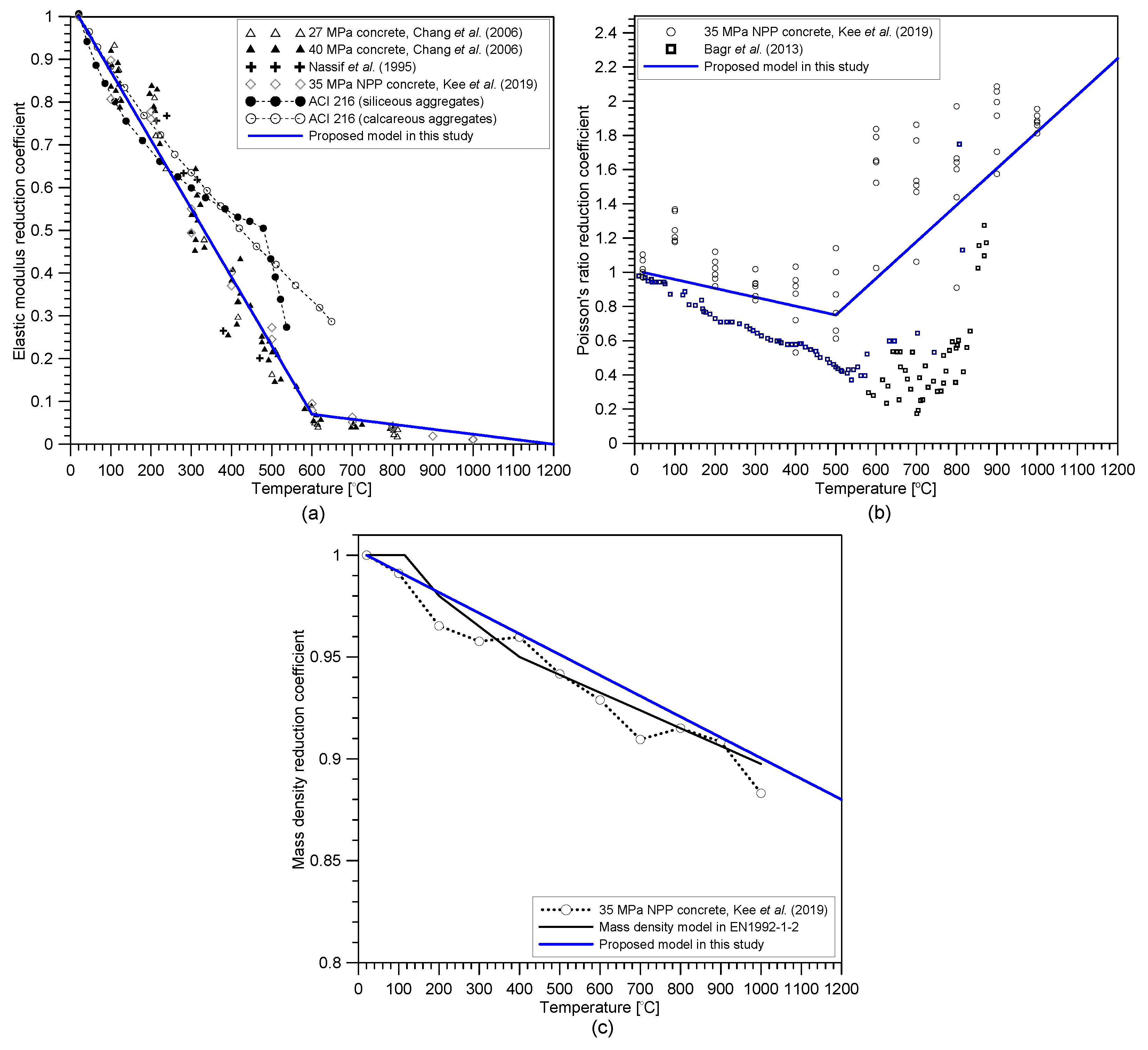
| β | |||||
|---|---|---|---|---|---|
| 20 | 600 | 1200 | 0.07 | 0 | |
| 20 | 500 | 1200 | 0.75 | 2.5 | |
| 20 | 1200 | - | 0.90 | - |
References
- Neville, A.M. Properties of Concrete, 4th ed.; John Wiley & Sons Inc.: New York, NY, USA, 1997. [Google Scholar]
- Ma, Q.; Guo, R.; Zhao, Z.; Lin, Z.; He, K. Mechanical properties of concrete at high temperature—A review. Constr. Build. Mater. 2015, 93, 371–383. [Google Scholar] [CrossRef]
- Schneider, U. Concrete at high temperatures—A general review. Fire Saf. J. 1988, 13, 55–68. [Google Scholar] [CrossRef]
- Kodur, V. Properties of Concrete at Elevated Temperatures. ISRN Civ. Eng. 2014, 2014, 468510. [Google Scholar] [CrossRef]
- Sansalone, M.; Carino, N.J. Detecting Delaminations in Concrete Slabs with and without Overlays Using the Impact-Echo Method. ACI Mater. J. 1989, 86, 175–184. [Google Scholar]
- Sansalone, M.J.; Strett, W.B. Impact-echo: Nondestructive Evaluation of Concrete and Masonry; Bullblier press: Ithaca, NY, USA, 1997. [Google Scholar]
- Kee, S.-H.; Oh, T.K.; Popovics, J.S.; Arndt, R.W.; Zhu, J. Nondestructive Bridge Deck Testing with Air-Coupled Impact-Echo and Infrared Thermography. J. Bridg. Eng. 2012, 17, 928–939. [Google Scholar] [CrossRef]
- Gibson, A.; Popovics, J.S. Lamb Wave Basis for Impact-Echo Method Analysis. J. Eng. Mech. 2005, 131, 438–443. [Google Scholar] [CrossRef]
- Savva, A.; Manita, P.; Sideris, K. Influence of elevated temperatures on the mechanical properties of blended cement concretes prepared with limestone and siliceous aggregates. Cem. Concr. Compos. 2005, 27, 239–248. [Google Scholar] [CrossRef]
- Lin, Y.; Hsiao, C.; Yang, H.; Lin, Y.-F. The effect of post-fire-curing on strength–velocity relationship for nondestructive assessment of fire-damaged concrete strength. Fire Saf. J. 2011, 46, 178–185. [Google Scholar] [CrossRef]
- Mróz, K.; Hager, I. Non-Destructive Assessment of Residual Strength of Thermally Damaged Concrete Made with Different Aggregate Types. IOP Conf. Series: Mater. Sci. Eng. 2017, 245, 32034. [Google Scholar] [CrossRef]
- Philleo, R. Some Physical Properties of Concrete at High Temperatures. J. Am. Concr. Inst. 1958, 29, 857–864. [Google Scholar]
- Phan, L.T.; Lawson, J.R.; Davis, F.L. Effects of elevated temperature exposure on heating characteristics, spalling, and residual properties of high performance concrete. Mater. Struct. 2001, 34, 83–91. [Google Scholar] [CrossRef]
- Bähr, O.; Schaumann, P.; Bollen, B.; Bracke, J. Young’s modulus and Poisson’s ratio of concrete at high temperatures: Experimental investigations. Mater. Des. 2013, 45, 421–429. [Google Scholar] [CrossRef]
- Shin, S.-W.; Kim, S.-Y.; Kim, J.-S. Applicability of Impact-Echo Method for Assessment of Residual Strength of Fire-Damaged Concrete. J. Korea Inst. Struct. Maint. Insp. 2013, 17, 105–112. [Google Scholar] [CrossRef]
- Lee, J.C.; Lee, C.-J.; Kim, W.J.; Lee, J.H. Characteristics of Elastic Wave in Fire damaged High Strength Concrete using Impact-echo Method. Fire Sci. Eng. 2015, 29, 1–6. [Google Scholar] [CrossRef][Green Version]
- Park, S.-J.; Yim, H.J. Evaluation of residual mechanical properties of concrete after exposure to high temperatures using impact resonance method. Constr. Build. Mater. 2016, 129, 89–97. [Google Scholar] [CrossRef]
- Park, G.-K.; Yim, H.J. Evaluation of Fire-Damaged Concrete: An Experimental Analysis based on Destructive and Nondestructive Methods. Int. J. Concr. Struct. Mater. 2017, 11, 447–457. [Google Scholar] [CrossRef]
- Kee, S.-H.; Kang, J.W.; Choi, B.-J.; Kwon, J.; Candelaria, M.D. Evaluation of Static and Dynamic Residual Mechanical Properties of Heat-Damaged Concrete for Nuclear Reactor Auxiliary Buildings in Korea Using Elastic Wave Velocity Measurements. Materials 2019, 12, 2695. [Google Scholar] [CrossRef]
- Dilek, U. Assessment of Damage Gradients Using Dynamic Modulus of Thin Concrete Disks. ACI Mater. J. 2008, 105, 429–437. [Google Scholar]
- Dilek, U.; Leming, M.L. Comparison of Pulse Velocity and Impact-Echo Findings to Properties of Thin Disks from a Fire Damaged Slab. J. Perform. Constr. Facil. 2007, 21, 13–21. [Google Scholar] [CrossRef]
- Epasto, G.; Proverbio, E.; Venturi, V. Evaluation of fire-damaged concrete using impact-echo method. Mater. Struct. 2009, 43, 235–245. [Google Scholar] [CrossRef]
- Krzemień, K.; Hager, I. Post-fire assessment of mechanical properties of concrete with the use of the impact-echo method. Constr. Build. Mater. 2015, 96, 155–163. [Google Scholar] [CrossRef]
- Whelan, M.; Tempest, B.; Scott, D.B. Post-Fire Nondestructive Evaluation of a Prestressed Concrete Double-Tee Joist Roof. J. Perform. Constr. Facil. 2015, 29, 04014055. [Google Scholar] [CrossRef]
- Pazdera, L.; Dvořák, R.; Hoduláková, M.; Topolář, L.; Mikulášek, K.; Smutny, J.; Chobola, Z. Application of Acoustic Emission Method and Impact Echo Method to Structural Rehabilitation. Key Eng. Mater. 2018, 776, 81–85. [Google Scholar] [CrossRef]
- KS D 3504-2019. Steel Bars for Concrete Reinforcement; Korean Standards Association (KSA): Seoul, Korea, 2019. [Google Scholar]
- ASTM E119-20. Standard Test Methods for Fire Tests of Building Construction and Materials; ASTM International: West Conshohocken, PA, USA, 2020. [Google Scholar]
- KS C 1602-2019. Thermocouples; Korean Standards Association (KSA): Seoul, Korea, 2019. [Google Scholar]
- Piezotronics, Product Specification Sheet: PCB 352C33. Available online: https://www.pcb.com/spec_sheet.asp?m=352C33 (accessed on 8 August 2019).
- Shi, Y.; Wooh, S.-C.; Orwat, M. Laser-ultrasonic generation of Lamb waves in the reaction force range. Ultrasonics 2003, 41, 623–633. [Google Scholar] [CrossRef]
- Popovics, J.S.; Song, W.; Achenbach, J.D.; Lee, J.H.; Andre, R.F. One-Sided Stress Wave Velocity Measurement in Concrete. J. Eng. Mech. 1998, 124, 1346–1353. [Google Scholar] [CrossRef]
- Lin, J.; Sansalone, M. A procedure for determining P-wave speed in concrete for use in Impact-echo testing using a Rayleigh wave speed measurement technique. ACI Symp. Pap. 1997, 168, 137–166. [Google Scholar]
- Ghasemi, A.; Zahediasl, S. Normality Tests for Statistical Analysis: A Guide for Non-Statisticians. Int. J. Endocrinol. Metab. 2012, 10, 486–489. [Google Scholar] [CrossRef]
- Poon, C.-S.; Azhar, S.; Anson, M.; Wong, Y.-L. Strength and durability recovery of fire-damaged concrete after post-fire-curing. Cem. Concr. Res. 2001, 31, 1307–1318. [Google Scholar] [CrossRef]
- Yang, H.; Lin, Y.; Hsiao, C.; Liu, J.-Y. Evaluating residual compressive strength of concrete at elevated temperatures using ultrasonic pulse velocity. Fire Saf. J. 2009, 44, 121–130. [Google Scholar] [CrossRef]
- Cheng, C.-C.; Sansalone, M. Effects on Impact-Echo Signals Caused by Steel Reinforcing Bars and Voids around Bars. ACI Mater. J. 1993, 90, 421–434. [Google Scholar]
- Kee, S.-H.; Gucunski, N. Interpretation of Flexural Vibration Modes from Impact-Echo Testing. J. Infrastruct. Syst. 2016, 22, 04016009. [Google Scholar] [CrossRef]
Publisher’s Note: MDPI stays neutral with regard to jurisdictional claims in published maps and institutional affiliations. |

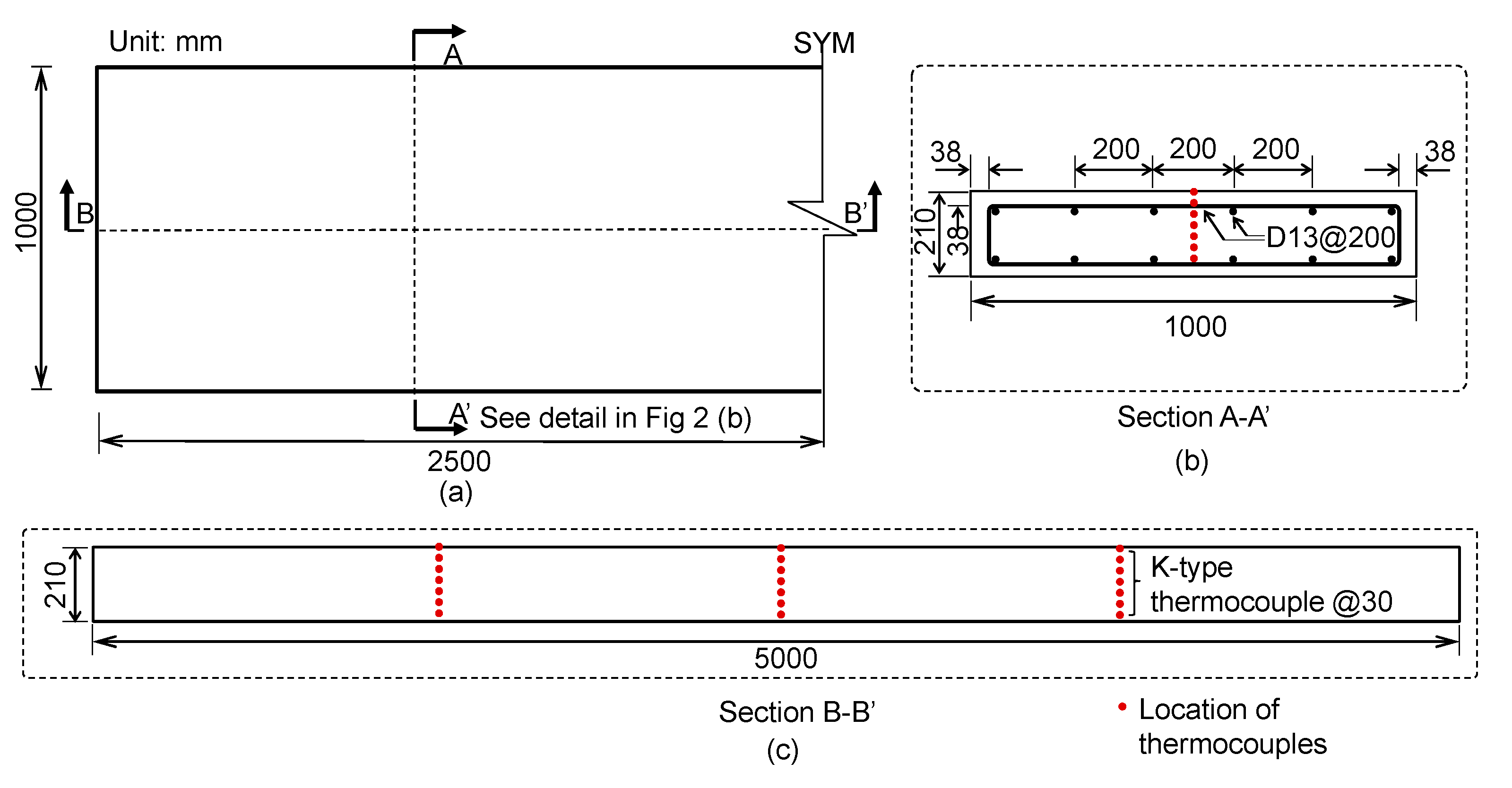

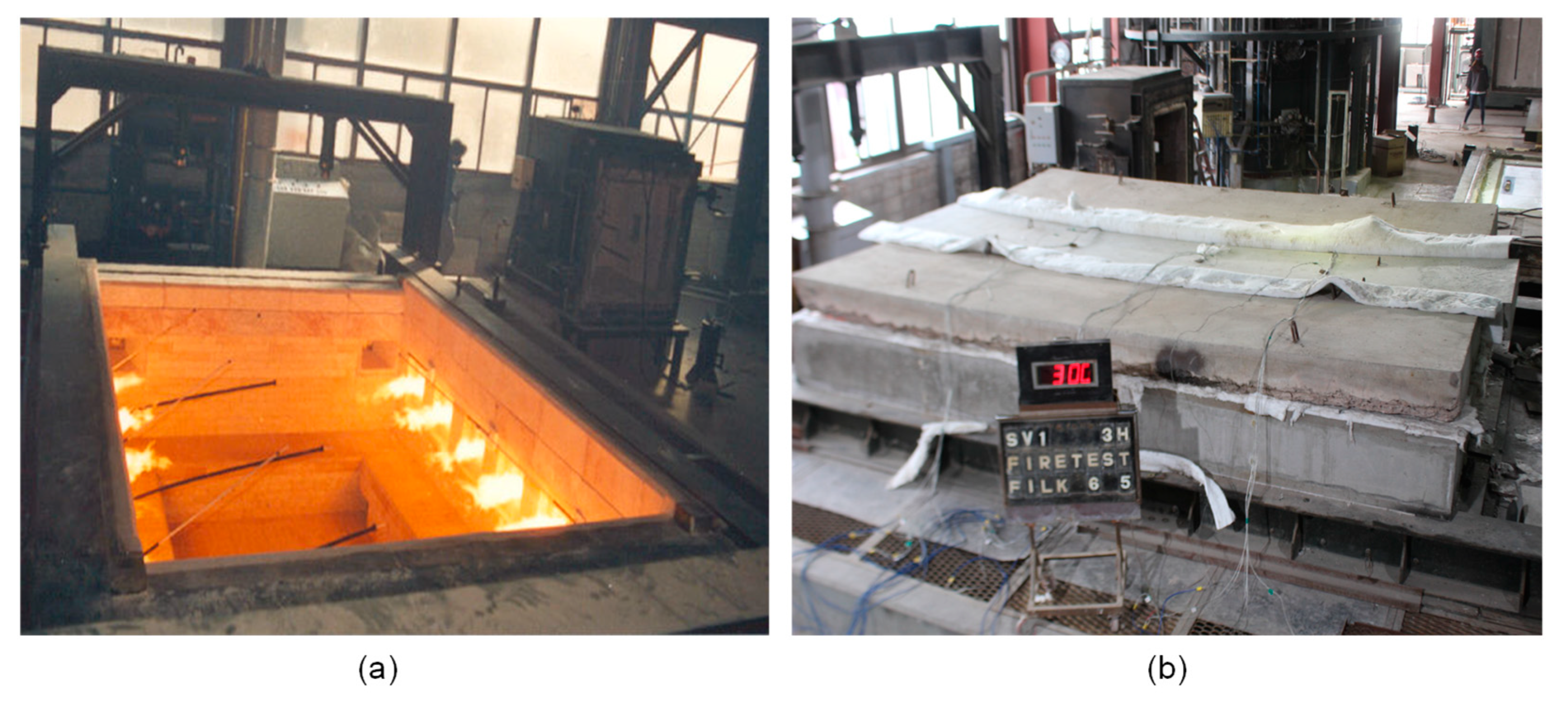
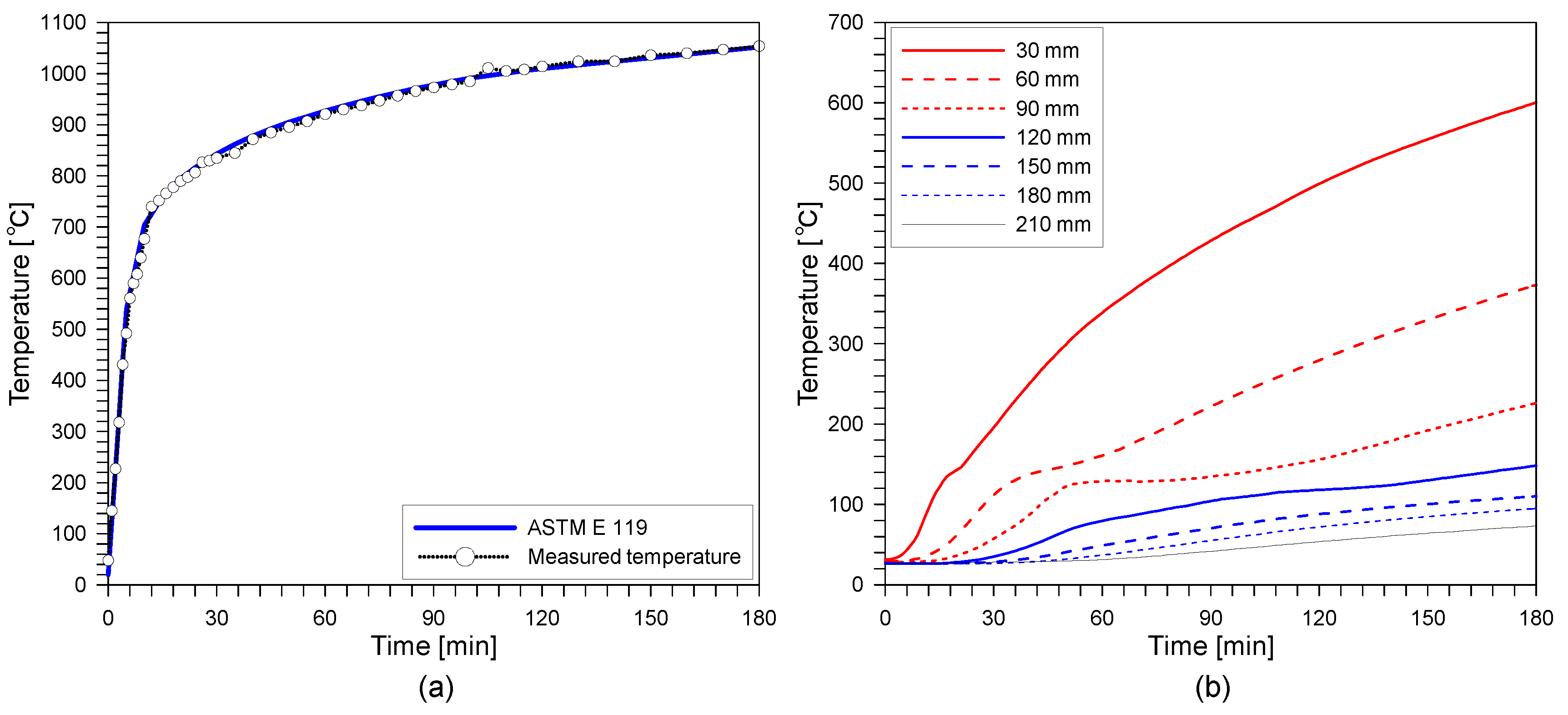
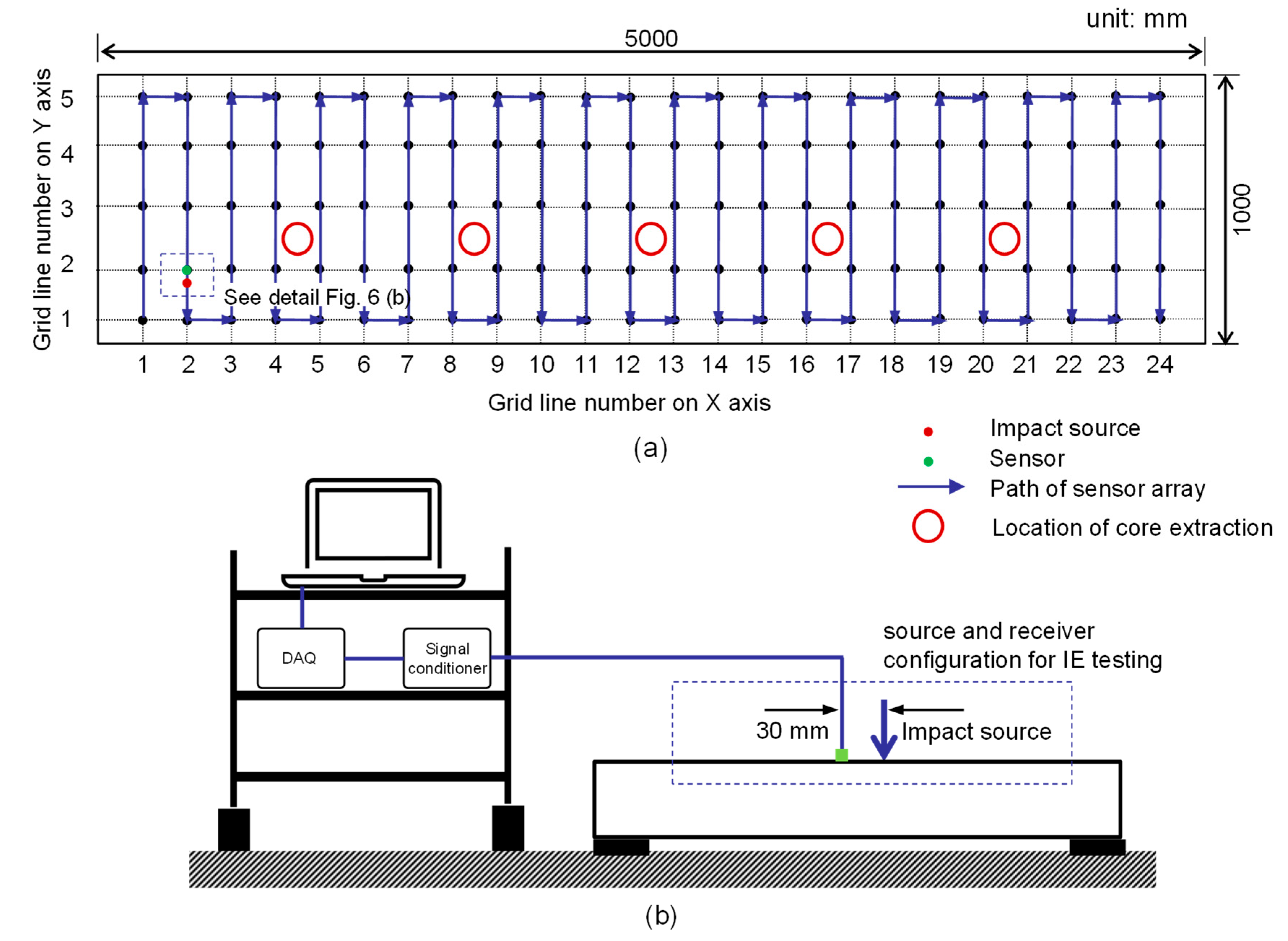
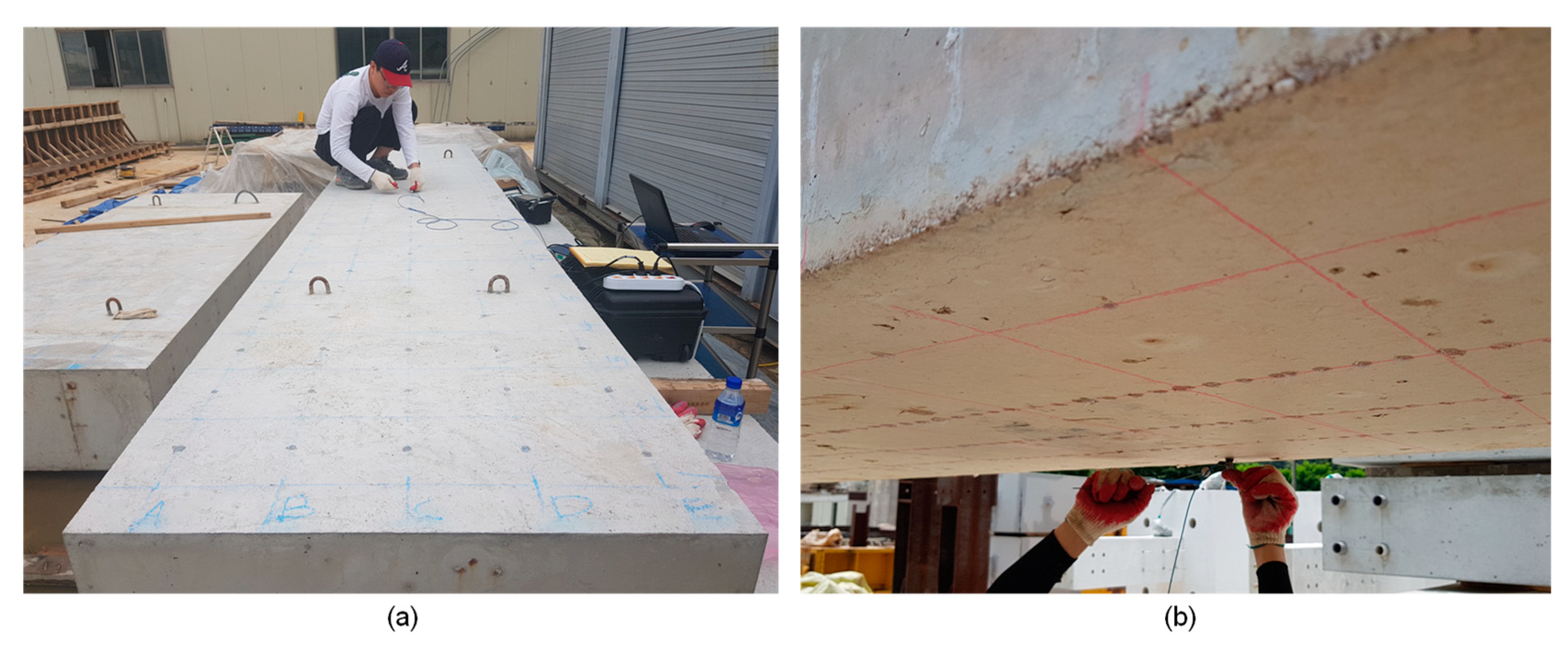
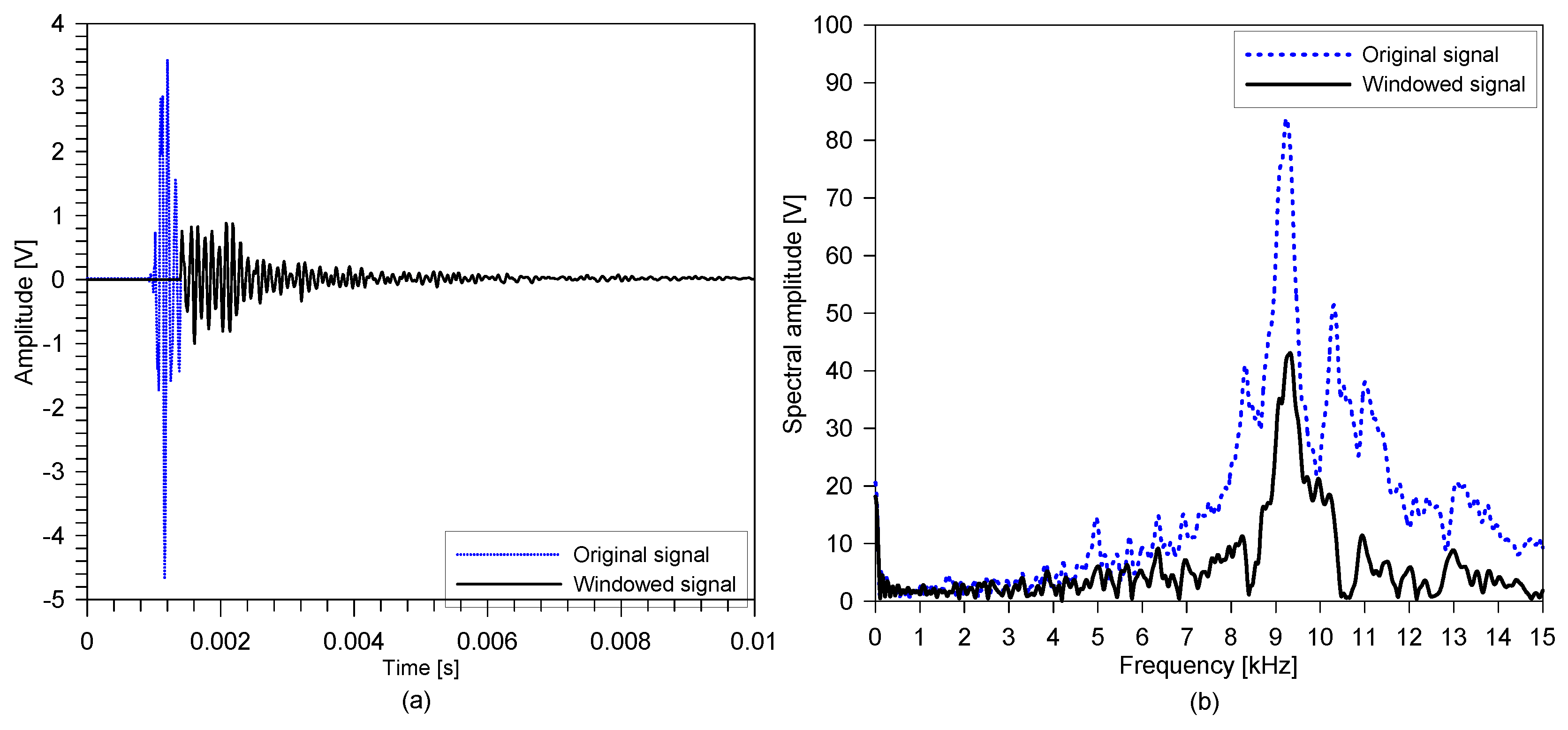
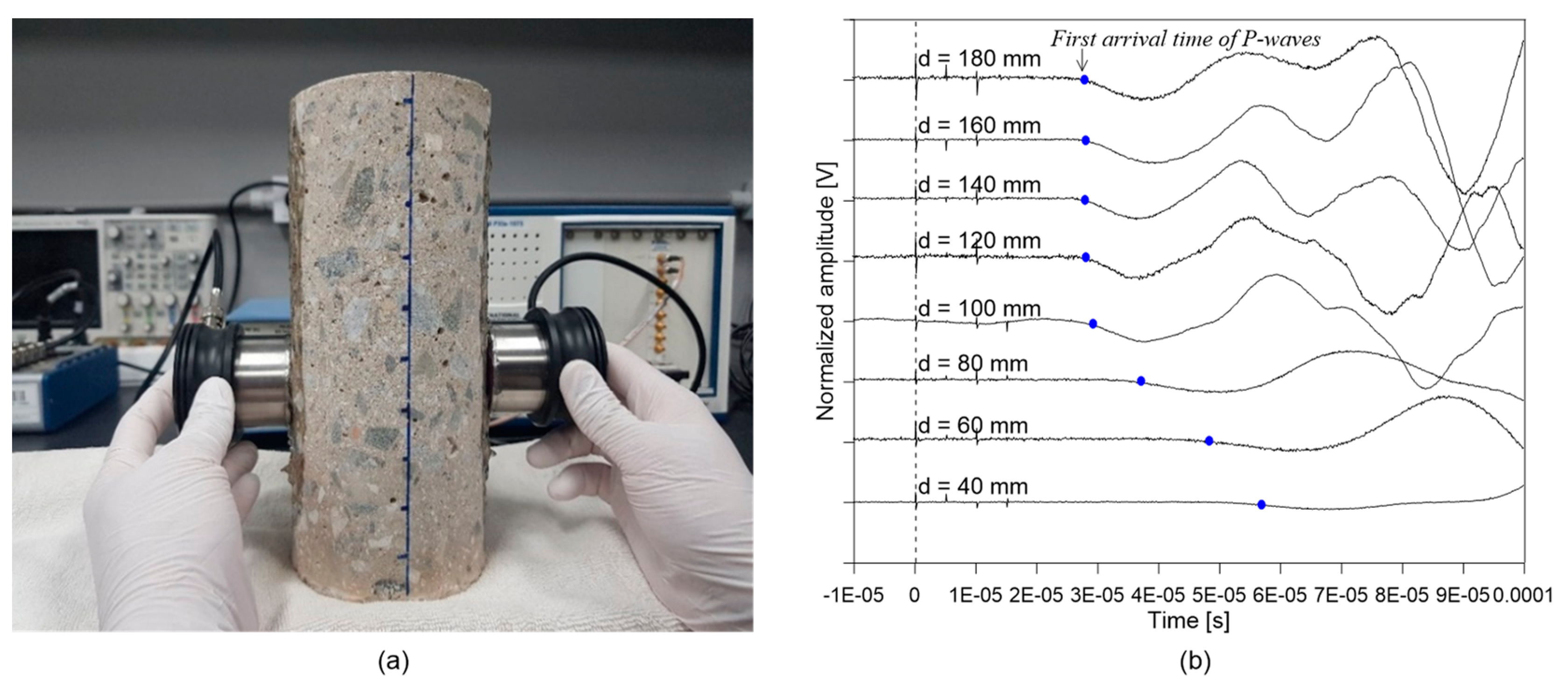


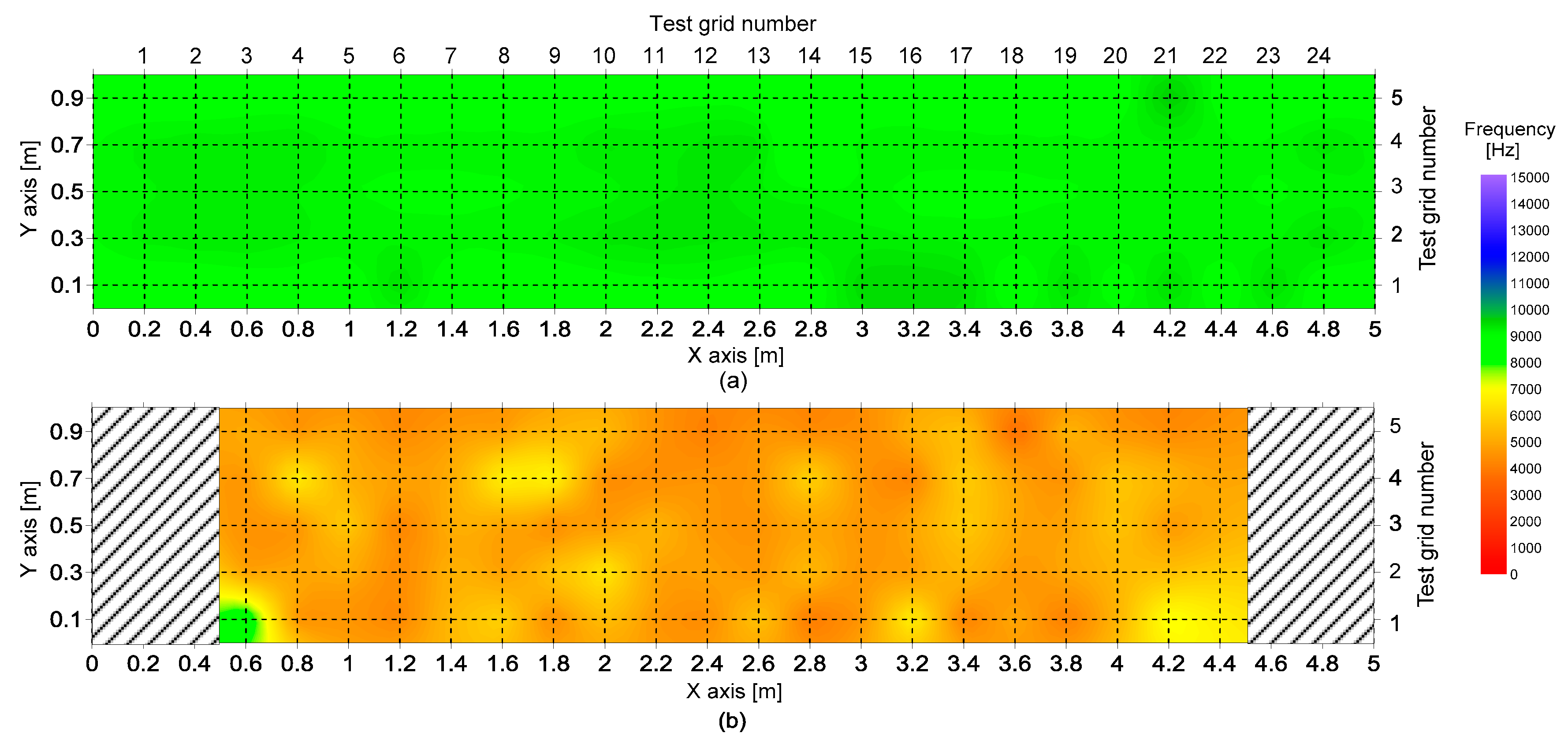
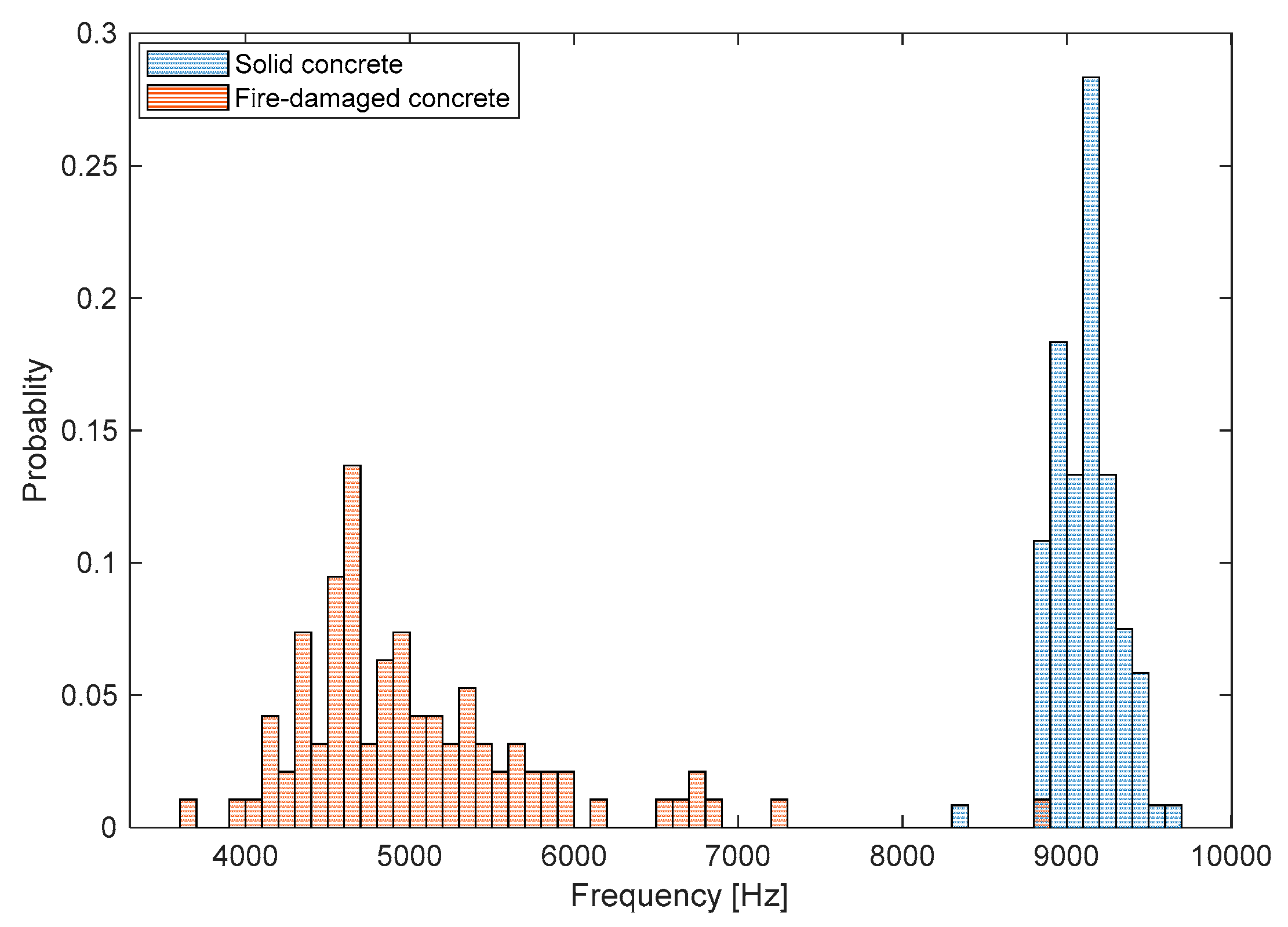



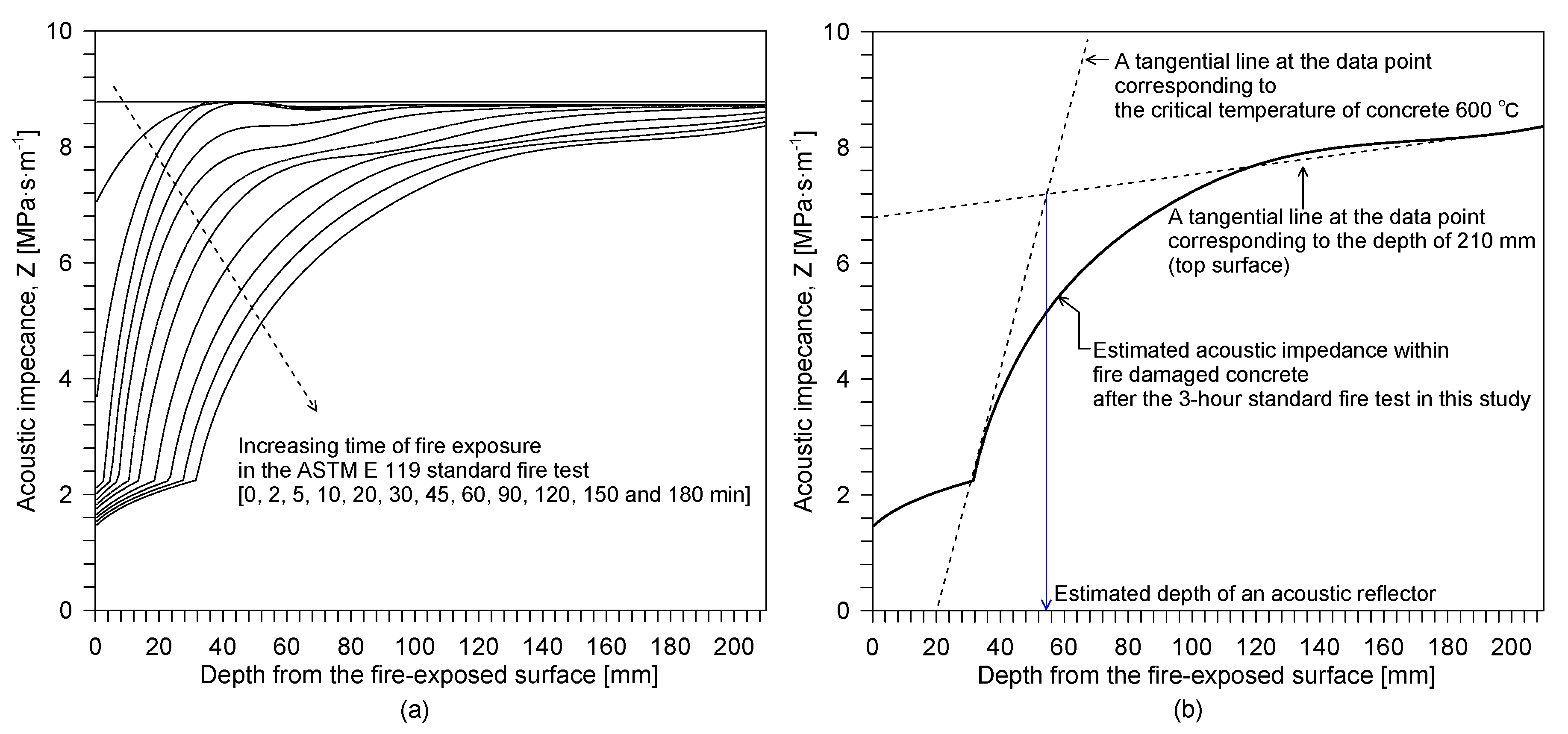
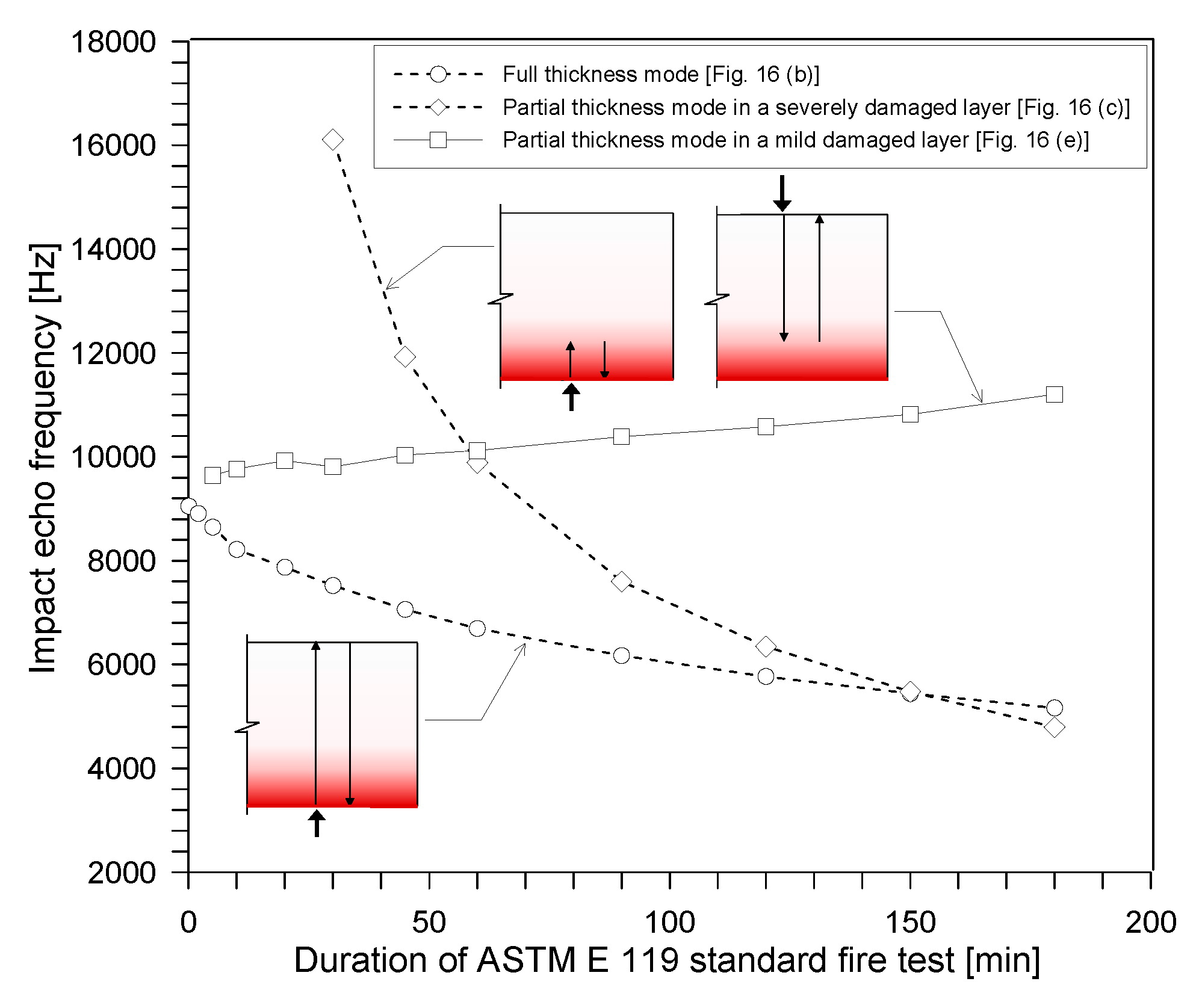
| ID | K-S Test Results | Mean [Hz] | Standard Deviation [Hz] | COV [%] | |
|---|---|---|---|---|---|
| h | p-Value | ||||
| Group 1 | 0 | 0.4415 | 9117 | 189 | 2.08 |
| Group 2 | 0 | 0.0683 | 5034 | 792 | 15.74 |
© 2020 by the authors. Licensee MDPI, Basel, Switzerland. This article is an open access article distributed under the terms and conditions of the Creative Commons Attribution (CC BY) license (http://creativecommons.org/licenses/by/4.0/).
Share and Cite
Lee, C.; Kee, S.-H.; Kang, J.W.; Choi, B.-J.; Lee, J.W. Interpretation of Impact-Echo Testing Data from a Fire-Damaged Reinforced Concrete Slab Using a Discrete Layered Concrete Damage Model. Sensors 2020, 20, 5838. https://doi.org/10.3390/s20205838
Lee C, Kee S-H, Kang JW, Choi B-J, Lee JW. Interpretation of Impact-Echo Testing Data from a Fire-Damaged Reinforced Concrete Slab Using a Discrete Layered Concrete Damage Model. Sensors. 2020; 20(20):5838. https://doi.org/10.3390/s20205838
Chicago/Turabian StyleLee, Changkye, Seong-Hoon Kee, Jun Won Kang, Byong-Jeong Choi, and Jin Woo Lee. 2020. "Interpretation of Impact-Echo Testing Data from a Fire-Damaged Reinforced Concrete Slab Using a Discrete Layered Concrete Damage Model" Sensors 20, no. 20: 5838. https://doi.org/10.3390/s20205838
APA StyleLee, C., Kee, S.-H., Kang, J. W., Choi, B.-J., & Lee, J. W. (2020). Interpretation of Impact-Echo Testing Data from a Fire-Damaged Reinforced Concrete Slab Using a Discrete Layered Concrete Damage Model. Sensors, 20(20), 5838. https://doi.org/10.3390/s20205838






